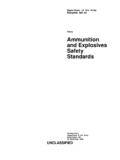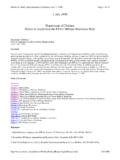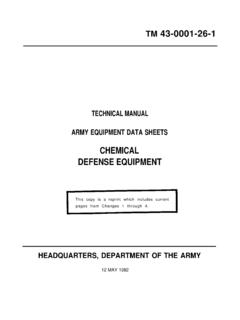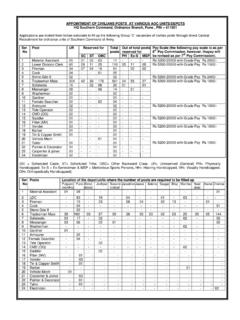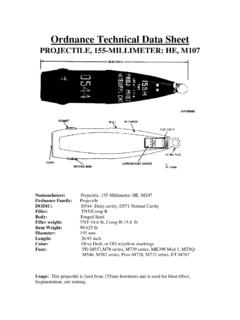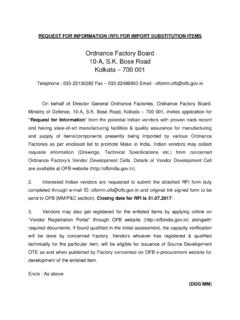Transcription of Responsibilities and Procedures for Explosive …
1 Army Regulation 75 15. explosives Responsibilities and Procedures for Explosive ordnance disposal Headquarters Department of the Army Washington, DC. 1 November 1978. UNCLASSIFIED. SUMMARY of CHANGE. AR 75 15. Responsibilities and Procedures for Explosive ordnance disposal Headquarters *Army Regulation 75 15. Department of the Army Washington, DC. 1 November 1978 Effective 1 January 1979. explosives Responsibilities and Procedures for Explosive ordnance disposal Army electronic publishing database. No one copy of each supplement to HQDA. content has been changed. (DALO-SMD-EOD), WASH DC 20310;. Summary. This is a complete revision of other commands will furnish one copy of AR 75-15. Changes are primarily con- each to the next higher headquarters. cerned with clarification of Department of the Army and major Army command re- Suggested Improvements. Users are sponsibilities. invited to send comments and suggested Applicability.
2 Not applicable. improvements on DA Form 2028 (Recom- Proponent and exception authority. mended Changes to Publications and The proponent agency of this regulation is Blank Forms) direct to HQDA (DALO- the Office of the Deputy Chief of Staff SMD-EOD) WASH DC 20310. for Logistics. Army management control process. Distribution. To be distributed in ac- Not applicable. cordance with DA Form 12-9A require- Supplementation. This regulation may ments for AR, explosives . be supplemented at major command and Active Army: A. History. This publication has been ARNG: None reorganized to make it compatible with the field army levels. Army Staff agencies and major Army commands will furnish USAR: D. Contents (Listed by paragraph and page number). Chapter 1. GENERAL, page 1. General. 1 1, page 1. Purpose and applicability. 1 2, page 1. Explanation of terms. 1 3, page 1. Mission. 1 4, page 2.
3 EOD staff officers. 1 5, page 2. EOD qualification and training. 1 6, page 3. Security classification of EOD tools, equipment, and Procedures . 1 7, page 3. EOD Coordinating Group. 1 8, page 3. Demolition duty orders for EOD personnel. 1 9, page 3. Chapter 2. Responsibilities , page 3. Department of the Army. 2 1, page 3. Major Army commands. 2 2, page 4. US Army Materiel Development and Readiness Command (DARCOM). 2 3, page 5. US Army Forces Command. 2 4, page 6. US Army Training and Doctrine Command. 2 5, page 6. Oversea commands. 2 6, page 7. Local commanders. 2 7, page 7. EOD unit commanders and officers in charge of EOD TDA elements. 2 8, page 8. *This regulation supersedes AR 75-15, 16 August 1976. AR 75 15 1 November 1978 i UNCLASSIFIED. Contents Continued Chapter 3. STANDARDIZATION OF RECOVERY AND DISPOSITION Procedures , page 8. General. 3 1, page 8. disposal of nonmilitary commercial-type explosives , chemicals or dangerous articles.
4 3 2, page 8. disposal of military explosives and other dangerous articles involved in accidents or incidents when shipped by commercial carriers. 3 3, page 9. Transportation and disposal of military chemical agents (see para 1-3). 3 4, page 9. Additional disposition Procedures . 3 5, page 10. Chapter 4. NUCLEAR WEAPONS, page 10. Section 1. GENERAL, page 10. EOD priorities of action in support of Nuclear Accident and Incident Control (AR 50-5) (NAIC) operations. 4 1, page 11. Additional Responsibilities of major Army commands. 4 2, page 11. EOD unit commanders and EOD officers in charge of NAIC EOD response teams. 4 3, page 11. Section II. NUCLEAR WEAPONS DOCUMENT SECURITY REQUIREMENTS, page 11. General. 4 4, page 11. Area security. 4 5, page 11. Security requirements for EOD/NW procedure publications. 4 6, page 12. EOD nuclear weapon publications accounts for non-EOD units and elements.
5 4 7, page 12. Review of EOD nuclear weapons publications accounts. 4 8, page 12. Chapter 5. IMPROVISED Explosive DEVICES (IED), page 12. Section I. GENERAL, page 13. General. 5 1, page 13. Policy. 5 2, page 13. Section II. FBI BOMB DATA CENTER, page 13. General. 5 3, page 13. Policy. 5 4, page 13. Procedures . 5 5, page 13. Section III. CLASSIFICATION GUIDANCE, page 14. General. 5 6, page 14. Policy. 5 7, page 14. Procedures . 5 8, page 14. Section IV. Responsibilities , page 14. Major Army commands. 5 9, page 14. US Army Materiel Development and Readiness Command. 5 10, page 14. Section V. Procedures , page 15. Storage of hazardous items, materiels and IED components. 5 11, page 15. Court testimony. 5 12, page 15. ii AR 75 15 1 November 1978. Contents Continued Determination of render safe procedure (RSP). 5 13, page 15. DOD Industrial Facilities Protection Program. 5 14, page 15.
6 Improvised Explosive device searches. 5 15, page 15. Chapter 6. disposal OF DEPARTMENT OF DEFENSE Explosive RESIDUE, page 15. General. 6 1, page 15. Procedures . 6 2, page 16. Chapter 7. Explosive ordnance disposal SUPPORT TO THE US SECRET SERVICE, page 16. Section I. GENERAL, page 16. General. 7 1, page 16. Policy. 7 2, page 16. Section II. Responsibilities , page 16. Deputy Chief of Staff for Operations and Plans. 7 3, page 16. Deputy Chief of Staff for Logistics. 7 4, page 17. Major Army commands. 7 5, page 17. EOD detachments and personnel. 7 6, page 17. Section III. Procedures , page 17. US Secret Service. 7 7, page 17. Notification Procedures . 7 8, page 17. Reporting Procedures . 7 9, page 18. Section IV. MISSION SUPPORT INFORMATION, page 18. EOD support to VIP protection. 7 10, page 18. Clothing requirements. 7 11, page 18. Equipment requirement. 7 12, page 18. Transportation requests.
7 7 13, page 18. Use of special determination. 7 14, page 19. Identification. 7 15, page 19. Appendix A. Explosive ordnance disposal Activity And Status Report RCS (CSGLD-1712), page 20. Figure List Figure A 1: EOD Activity and Status Report, page 22. AR 75 15 1 November 1978 iii RESERVED. iv AR 75 15 1 November 1978. Chapter 1. GENERAL. 1 1. General. AR 75-14/OPNAVINST 136-8/MCO delineates areas of Responsibilities of Explosive ordnance disposal (EOD) for the Army, Navy, Marine Corps, and Air Force. 1 2. Purpose and applicability. This regulation prescribes Department of the Army EOD policies, Responsibilities , and Procedures . This regulation does not apply to the Army National Guard or the Army Reserve. 1 3. Explanation of terms. The following terms used in this regulation are pertinent to Explosive ordnance reconnaissance and disposal operations. a. Biological. As used herein, biological weapons, agents, operations, fillers, etc.
8 , refer to foreign ordnance and programs. b. Chemical agent. A chemical substance which is intended for use in military operations to kill, seriously injure, or incapacitate man through its chemical properties. Excluded from considerations are riot control agents, chemical herbicides, smoke and flame. c. Common type training. Training in EOD Procedures required by two or more services in the normal execution of their assigned missions. d. Contamination control line. A line established by competent authority identifying the area contaminated to a specific level of the contaminant of interest. e. Contamination control point. That portion of the contamination control line used by personnel to control entry to and exit from the contaminated area. f. Coordination. As used herein refers to the active participation between elements of the Services having an interest in EOD activities.
9 Agencies coordinated with shall provide positive participation and shall not operate by default. g. Explosive ordnance (EO). All munitions containing explosives , nuclear fission or fusion materials and biological and chemical agents. This includes bombs and warheads; guided and ballistic missiles; artillery, mortar, rocket and small arms ammunition; all mines, torpedoes and depth charges, demolition charges; pyrotechnics; clusters and dispensers; cartridge and propellant actuated devices; electro- Explosive devices; clandestine and improvised Explosive devices; improvised nuclear devices; and all similar or related items or components Explosive in nature. h. Explosive ordnance disposal (EOD). The detection, identification, field evaluation, rendering-safe, recovery and final disposal of unexploded Explosive ordnance . It may also include the rendering safe and/or disposal of Explosive ordnance which have become hazardous by damage or deterioration when the disposal of such Explosive ordnance is beyond the capabilities of personnel normally assigned the responsibility for routine disposal .
10 Note. Does not include normal operations identified with minefield clearance. This regulation does not change present responsibili- ties of all branches and services to clear landmines and boobytraps to the extent necessary for the continued movement and operation as well as within their own bivouac and work areas; these activities however, may request technical advice and assistance from EOD personnel, when required. i. EOD Control Center (EODCC). A designated unit which provides operational control, planning and administra- tive services related to EOD operations for assigned EOD units in a designated geographical area of responsibility. These centers receive notification of an EOD incident and completed incident reports from subordinate units, and provide scheduling and control of disposal operations and the routing of technical intelligence information. j. Explosive ordnance disposal incident (EOD incident).

